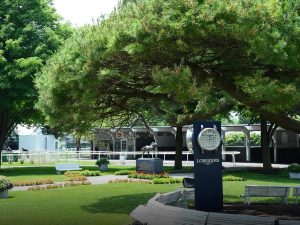By Noel Michaels
New York racing returns downstate for Belmont Park’s fall championship meet, which, as usual, offers top-notch racing throughout the season. Here are some pointers that may assist you in increasing your bankroll.

Belmont Park – Photo NYRA
For the average horseplayer, Belmont can be a much easier meet to win at than Saratoga because the field sizes are usually smaller, especially on dirt. Belmont, which runs from Friday (Sept. 18) through Nov. 1, offers many of the top 2-year-olds, the best turf racing of the season, and the most widely-inclusive stakes program of the fall season.
Since most of the horses running at Belmont are coming off starts at Saratoga, it would be very helpful to evaluate recent trends at the Spa.
A look at the dirt angles: distance
When handicapping dirt track races, the local horses who excelled at Saratoga are not necessarily the horses you want to bet at Belmont. While many of the best horses at Belmont were at the Spa, they were not necessarily the horses that won at the Spa. Often, it’s horses that skipped Saratoga or lost there that are the better bets — at better prices.
One reason for Saratoga-to-Belmont form reversals is that horses with the best form upstate were excelling, in part, thanks to their preference for two-turn dirt route races at Saratoga.
However, this factor flip-flops at Belmont, away from helping the two-turn specialists, and instead favors the one-turn horses who like the routes at Belmont. Also, horses better at a mile and 1 1/16 miles have better chances back at Belmont versus the ones who liked the 1 1/8-mile dirt routes run at Saratoga.
At Saratoga, because of the track layout, there were no mile races and no 1 1/16-mile races on dirt. The vast majority of all main track Saratoga routes are run at 1 1/8 miles. This creates lots of problems for horses whose best distances are a mile and/or 1 1/16 miles. At the Spa, those horses must either stretch out to 1 1/8 miles (too long), or cut back to 7 furlongs around one turn (too short). When those horses return to Belmont in the fall, they often come off a bad recent race or two, and they are ready for a positive turnaround, often at a good price, back at their preferred distances,
Closer look at dirt sprints
Another dirt angle to use at Belmont involves Saratoga sprints, which favored horses breaking from posts 1-6 all season. Horses breaking from posts 7 and outward in Spa dirt sprints won a total of only 17 of the 164 dirt sprints from a combined 241 starters from those posts for 7%. Bet dirt sprinters exiting losses from outside posts at Saratoga when they get back to Belmont.
Also watch for the horses returning from layoffs during Saratoga who never left Belmont Park to go upstate – distance preferences in many cases. Now they are rested and ready to run and have been pointed to races in the condition book at Belmont all along. This angle is most pertinent right now!

Belmont Park – Photo NYRA
Checking the inner and outer turf differences
Now moving to Belmont turf racing. Both the inner turf and the outer turf courses are big, wide, and fair, and feature long stretch runs. Outside turf posts are a concern between a mile and 1 1/8 miles, but less so at other distances. Horses breaking from the far outside in 1-mile races and 1 1/16-mile races can be most negatively affected by outside posts.
Belmont’s 6-furlong and 7-furlong turf sprints are a whole different ballgame than at Saratoga. Speed horses that were successful in Saratoga’s 5 ½-furlong turf sprints often underperform at the Belmont fall meet at low prices. Closers and stalkers and pace-pressers, meanwhile, have an opportunity to do much better at Belmont, especially if they draw post positions toward the outside. These horses didn’t have enough real estate to work with at Saratoga.
And don’t forget to check on turf race post positions
Turf sprint post positions are important, too. The inside turf sprint posts are tough at Saratoga, and outside draws are advantageous. Bet horses that lost from the Saratoga turf sprint rail post when they run back at Belmont. Even at Belmont, in turf sprints, remember that long-term stats indicate outside posts are better than inside.
In turf routes run at Saratoga this year, post positions were remarkably fair on the inner turf, with horses winning at decent percentages from all posts out to Post 12. The Mellon (outer) turf course at Saratoga, however, was a different story. Most turf routes run on the Mellon turf this season were won by horses breaking from posts 1-6, with wins in 28 of the 35 races run. Horses breaking from posts 7-12 won just seven races, and were a combined 7-for-84 for 8%. When you see horses exiting turf losses from those posts, upgrade that horse at Belmont.
Inner turf insight
There is also a Belmont handicapping angle for horses exiting inner turf course races at Saratoga. It involves running styles. The Spa inner turf carries speed under firm conditions. These horses are going to come back in droves at Belmont and provide a strong betting angle. When you see horses at Belmont who won or ran big with front-running efforts on Saratoga’s inner turf, perhaps you can downgrade those horses in their next starts. Conversely, when you see a horse exiting a Saratoga loss or sub-par effort(s) with a late-closing running style, you can go ahead and upgrade it at Belmont because that kind of running style is a bit disadvantaged on the inner turf at Saratoga.
These tips, angles, and trends give you an edge at the betting windows for a successful and enjoyable 2020 fall meet. Focusing on some significant Belmont handicapping quirks, as well as the differences between Belmont and Saratoga, can help you pick more winners.

Noel Michaels has been involved in many aspects of thoroughbred racing for more than two decades, as a Breeders’ Cup-winning owner and as a writer, author, handicapper, editor, manager and promoter of the sport for a wide range of companies including Daily Racing Form and Nassau County Off-Track Betting.
He also is regarded as the leading source of news and information for handicapping tournaments and the author of the “Handicapping Contest Handbook: A Horseplayer’s Guide to Handicapping Tournaments”, which made his name virtually synonymous with the increasingly-popular tournament scene.
In addition to contributing to US Racing, he is also an analyst on the Arlington Park broadcast team.


